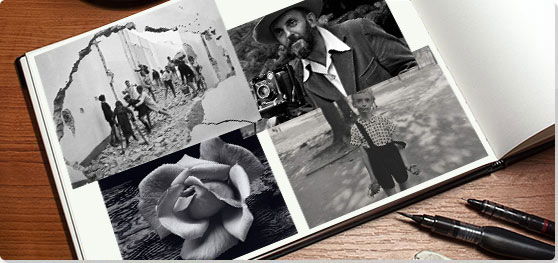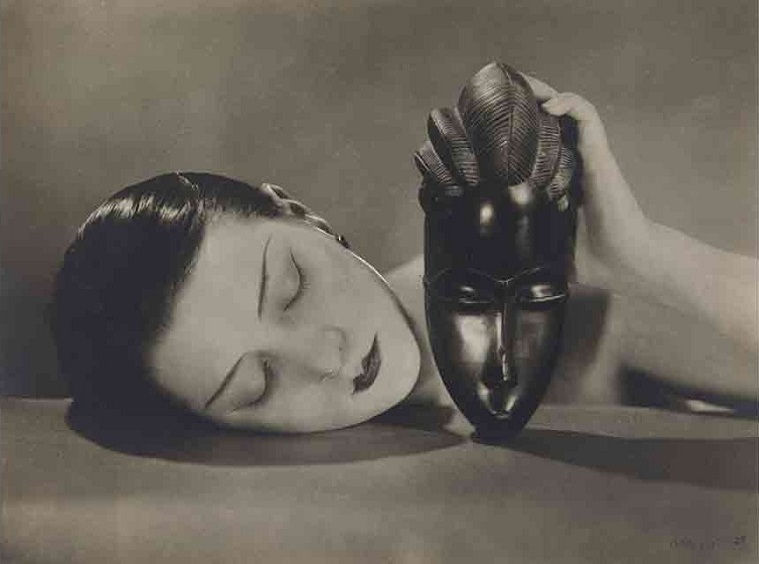Summary of Straight Photography
Straight photography emphasizes and engages with the camera's own technical capability to produce images sharp in focus and rich in detail. The term generally refers to photographs that are not manipulated, either in the taking of the image or by darkroom or digital processes, but sharply depict the scene or subject as the camera sees it. Paul Strand and Alfred Stieglitz pioneered Straight photography in New York while the Hungarian-born László Moholy Nagy exploited pure photography to maximize the graphic structure of the camera-image. These straight or pure approaches to photography continue to define contemporary photographs, while being the foundation for many related movements, such as Documentary, Street photography, Photojournalism, and even later Abstract photography.
Key Ideas & Accomplishments
- Straight photography for the first time, since the invention of photography, respects the medium's own technical visual language. The camera's distinctive vocabulary includes form, sharp focus, rich detail, high contrast, and rich tonalities. Straight photography is also synonymous with pure photography, since both terms describe the camera's ability to faithfully reproduce an image of reality.
- Straight photographers visualized the image before taking the photo. Edward Weston defined this term in 1921 and stated: "Get your lighting and exposure correct at the start and both the developing and printing can be practically automatic." Ansel Adams could not agree more when he asserted "the photographer visualizes his conception of the subject as presented in the final print. He achieves the expression of his visualization through his technique - aesthetic, intellectual, and mechanical." This visualization of the image was complemented by format cameras - a camera that used large film sizes either 4x5 in. or 8x10 in. - that enabled the photographer to preview the scene on the ground glass.
- László Moholy-Nagy's notion of New Vision (Neues Sehen) of photography has close ties to the ideas of the Bauhaus school. His technique looked at the world through the camera lens, using it both as a framing device for documenting and as a means of experimentation. Moholy-Nagy, intent on creating a graphic structure in the image, championed unconventional viewpoints and playful printing techniques to develop a fresh rapport with the visible, industrial world.
- Straight photography is a process- and time-based approach. It represents immediacy, the passing of time as in history, or the freezing of time as in a snapshot. In a photograph, time is described by the movements of the subject. As Henri Cartier-Bresson stated "we work in unison with movement as though it were a presentiment on the way in which life itself unfolds. But inside movement there is one moment in which the elements in motion are in balance." This notion of the "decisive moment" defined much of the Straight photography of the mid-20th century.
Important Photographs and Artists of Straight Photography
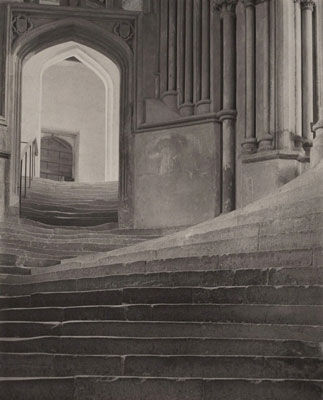
'A Sea of Steps', Wells Cathedral, Steps to Chapter House
This image depicts steps ascending to the Chapter House in Wells Cathedral in Somerset, England. Remarkable for its composition and sense of light and space, the photograph conveys the climbing up the stairs, as if analogous to ascending toward the divine serenity symbolized by the illuminated archway. The vertical lines of the columns rise out of the curve of the steps that seem to flow and swell like ocean waves; what Evans' called "a sea of steps." As a result, Evans introduced a new departure in photography. He drew on the Symbolist manner of using objects to directly express esoteric ideas. Evans framed the interior view of the flight of stairs (an architectural space) to suggest the ascent up the sancta scala (holy stair), giving the image an emotional and spiritual resonance.
Evans was a bookseller who began experimenting with photography and in 1898 became a professional photographer, focusing on architectural subjects, in particular noted cathedrals in France and England. A member of the Pictorialist Linked Ring Society in London, he represented the extreme Purist approach within the Society. Evans practiced and advocated for a purely photographic image - thus he was a patriarch of Straight photography. A perfectionist, he would sometimes spend weeks in a cathedral studying the effects of light at different times of the day to capture the perfect image. Light, he felt, was the equivalent of spiritual enlightenment.
Platinum Print - The Philadelphia Museum of Art, Philadelphia
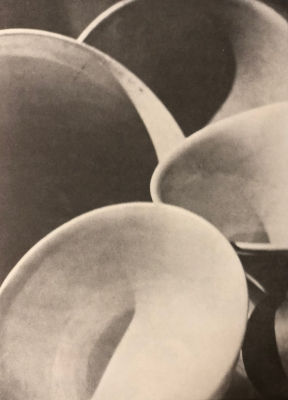
Bowls
This photograph depicts a close-up view of regular kitchen bowls that are used to study the effects of light and shadow. The round, concave objects are reduced to geometric circular shapes, defined by the highlighted linear top edge of the bowls and the depth of the shadows. The composition of overlapping circular shapes dismantles the structure of the object, making it almost abstract, and not easily recognizable. Paul Strand said that his "abstract" studies were a matter of clarifying "for me what I now refer to as the abstract method, which was first revealed in the paintings of Picasso, Braque, Léger and others... ." These close-up shots parallel his close-up portraits of ordinary people taken in the street at the end of 1916, which border on social documentary.
Strand's work, published in the last issue of Camera Work in June 1917, went as far as possible in defining a photographic point of view. Significant here is the creative freedom found in the photographic act. Alfred Stieglitz added a short essay in support of this new aesthetic: "The work is brutally direct; devoid of all flim-flam; devoid of trickery and of any 'ism'; devoid of any attempt to mystify an ignorant public, including the photographers themselves." Strand's close-up photo of bowls introduced a new photography that objectively analyzes the features of ordinary people and objects.
Photogravure - Musée d'Orsay, Paris
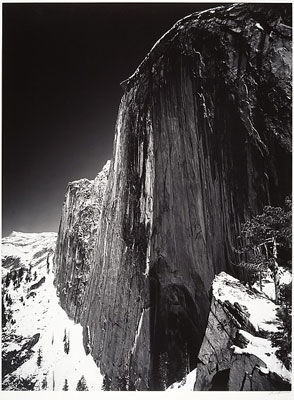
Monolith, the Face of Half Dome
Adam's photograph of Half Dome, a landmark of Yosemite Park in California, launched his career. This shaped granite rock formation is captured as a dark imposing monolith rising up to a distant peak against a dark sky and snowy landscape at its lower left and lower right. Throughout his life Adams returned to this subject and commented, "it is never the same Half Dome, never the same light or the same mood." This image was met with critical acclaim, and Adams himself felt it was "one of the most exciting moments of my photographic career," because he had his first instance of what he called "visualization," being able to see and frame the picture in his mind's eye.
To take the photograph, he climbed 4000 feet through snow, carrying his large Korona view camera, a wooden tripod, and a dozen glass plates that he set up on a rocky outcropping. When the light began to fall on the monolith, he took one photograph with a yellow filter, and then realized that using a dark red filter would make the image, as he said, "a brooding form, with deep shadows and a distant sharp white peak against a dark sky."
Adams was one of the leading members of Group f/64, along with Cunningham and Weston, and an ardent advocate for what he called "pure or straight photography." His landscapes were enormously popular with the general public, but critically influential to many photographs, like Harry Callahan who felt that Adam's focus on "just the straight photograph" set him free to pursue his own photographic practice.
1927 - The Metropolitan Museum of Art, New York New York
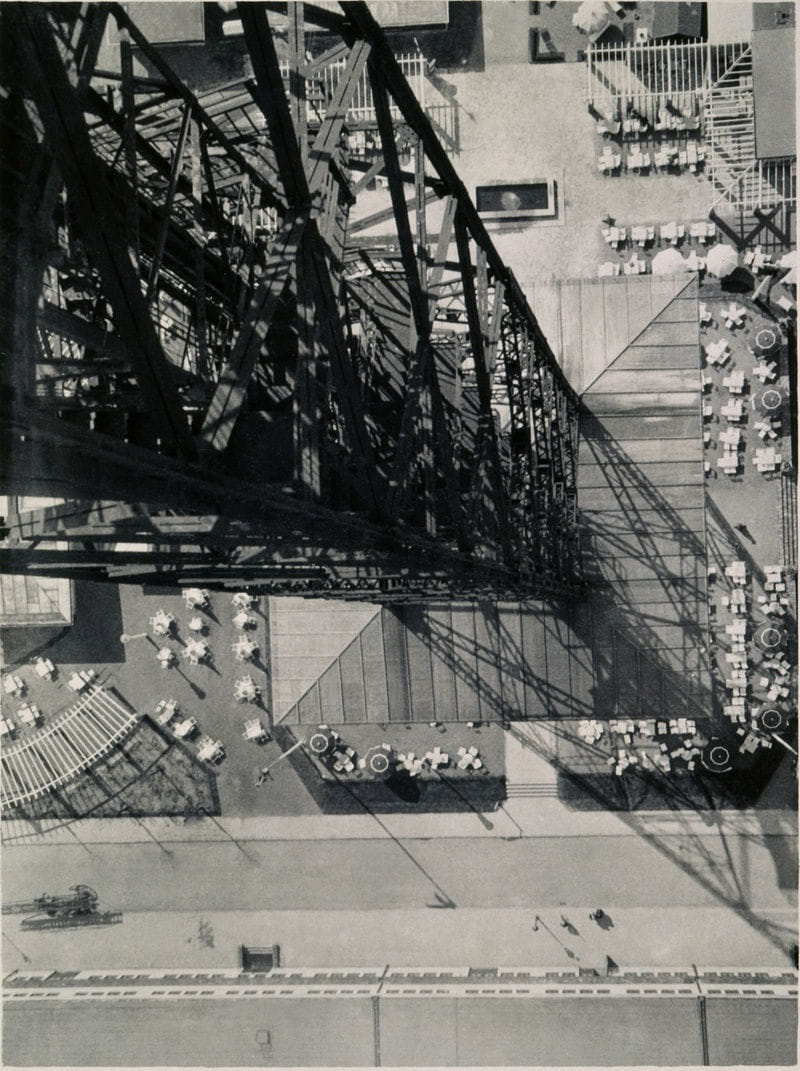
Funkturm Berlin (Berlin Radio Tower)
By using an aerial view, described by art historian Christopher Phillips as “the purposefully disorienting vantage point,” this photograph emphasizes geometric structure, creating a relationship between sharp bold angles and circular forms. The tower descends vertiginously, as it intersects the pictorial plane diagonally. Simultaneously, high contrasting tonalities give dimension and texture to the concrete grid at the tower’s base, the wire-like lines of the concentric circles, and the convex white circles and cross shapes arranged in symmetrical clusters. As a result, as art historian Lynne Warren wrote, “the spaces, shadows, and objects below intersect into a dense and abstract pattern, implicitly celebrating the technological and industrial shaping of modern life.” The use of line, creating a number of intersecting triangles, unifies the picture, while reflecting the artist’s innovative emphasis on modern technology, as the image becomes a kind of visual embodiment of radio transmission.
This photograph was one of a series that Moholy-Nagy took of the recently completed tower and reflects the ideas he expressed in Neue Sehen (New Vision) (1927), viewing photography as a way to explore, “the perspectives offered by the modern city — its high-rises and dramatic scales, its geometries of contrast, its industrial patterns and texts.” His experimental images were intended to let the viewer see space, and later in his essay "A New Instrument of Vision" (1932) he defined eight varieties of vision that summarized the conflict between a passive and active use of photographic space. This image takes an active, even aggressive approach, to that space, using Straight Photography to configure it dynamically.
Gelatin silver print - The Art Institute of Chicago, Chicago, Illinois
Escala de Escala (Ladder of Ladders)
This photograph focuses on the threshold of a coffin-maker's shop, where two ladders lean against the door and, behind them in shadow, coffins for children are stacked from floor to ceiling. On the upper right of the doorway, a small white coffin rests on a shelf, identifying the shop by its wares. Another small coffin sits on a table in the lower left of the image. It is open and a gramophone speaker rests inside it, evoking a poetic melody or reverie. The straight photograph is both undeniably real and surreal, as the shop's threshold is a metaphor for the transition between light and dark, life and death. The evocative title links the ladders against the door with the ladder-like effect of the stacked coffins. The result is dissonant, as if the idea of ascending to heaven were connected to the reality of death.
While working at a government job, Álvarez Bravo began to teach himself how to photograph. He achieved his earliest success around 1925, when he won first prize in a local photography competition in Oaxaca. Tina Modotti, who he befriended, influenced his work, and introduced him to Edward Weston as well as to a lively intellectual and creative milieu of artists, writers, and poets. His interest in folk art, particularly burial rituals and decorations, stem from his encounters with the Mexican mural painters, in particular Diego Rivera, and his photographic work for the journal Mexican Folkways. After meeting André Breton in 1938, he became associated with Surrealism. Breton promoted his work in France and subsequently asked Alvaréz Bravo for a photograph to use as a catalog cover for a Surrealist exhibition in Mexico. The result was La buena fama durmiendo (The good reputation sleeping) (1938-1939), a controversial image that was censored in Mexico for nudity but which became his best-known. Álvarez Bravo's ability to capture, based on a straight approach, everyday reality with its surrealist qualities became a signature of his work.
Gelatin silver print - The Museum of Modern Art, New York, New York
New York at Night
This aerial view of New York City at night, taken from a high-rise building, shows the lights of the buildings and streets glowing so that the rectangular forms of the high rises, the streets between, and the elevated train line seem incandescent and monumental. Abbott visited New York in the late 1920s to find a publisher for a collection of Eugène Atget's photographs. She was so struck by how the city was changing that she decided to undertake her photographic project, Changing New York.
Working as a darkroom assistant for the photographer Man Ray in Paris in the 1920s, Abbott turned seriously to photography when she was inspired by the work of Eugène Atget. She became a tireless promoter of his work.
Known for her rigorous standards and straight approach, many of her images, like this one, required meticulous planning. For this photograph, knowing that office workers left, shutting off the lights at 5 pm, she realized that only on the shortest day of the year could she take a photo depicting the lit up city beneath a dark sky. She explained: "This was a fifteen-minute exposure and I'm surprised the negative is as sharp as it is because these buildings do sway a bit. I knew I had no opportunity to make multiple exposures because the lights would start to go out shortly after 5:00 P.M. when the people began to go home and so it had to be correct on the first try." Abbott's ability to maximize the lighting of the city to illuminate her image demonstrates the challenging process of pure photography.
Gelatin silver print - The Museum of Modern Art, New York
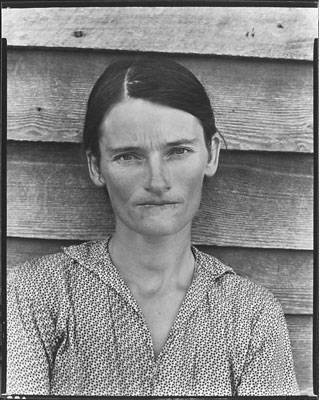
Allie Mae Burroughs, Hale County, Alabama
This portrait depicts Allie Mae Burroughs, the wife of an Alabama sharecropper and mother of four, as she stands against the side of her house. Though she was twenty-seven years old at the time, her face lined and worn from worry conveys the hard circumstances of her life. She looks at the camera sternly, and the horizontal lines of the wood siding behind her, emphasizing the lines of her mouth and eyebrows, convey the flatness of her expression. This image was one of several that Evans took of Mrs. Burroughs, each slightly different, but all reflecting the same honest and clear depiction - his documentary style. Her unreadable expression conveys a sense of her as a private person, rather than as a symbol of suffering.
Evans and James Agee spent the summer of 1936 with three tenant farming families in Alabama on assignment for Fortune magazine. Even though the magazine never published their story, Agee continued to work on the project. As a result, Evans and Agee published an enlarged and more ambitious work titled Let Us Now Praise Famous Men in 1941. Characterized as one of the most influential publications of the 20th century, Evan's signature photos, including this stark image, captured the effects of the Great Depression on the rural poor.
Film negative - The Metropolitan Museum of Art, New York
FRANCE. Normandy. June 6th, 1944. US troops assault Omaha Beach during the D-Day landings (first assault)
This photograph immortalized the allied forces coming ashore during the beach landing, known as the D-Day invasion. In the foreground a soldier lies prone in the water as he looks forward, his gun extended in front of him, while in the background, troop carriers can be seen, and objects floating in the water. The blurriness of the photo, due to the photographer being in the water himself, dodging bullets, conveys the feeling and urgency of the scene. The impelling energy, chaos, and risk of the invasion are conveyed.
With his coverage of the Spanish Civil War, Capa became the acclaimed war photographer of his generation. He was the only photographer to go ashore with the D-Day invasion, and this image, along with others that he took of the invasion, became part of the national consciousness. As the photo-historian Sally Stein comments "...in the nexus of war, modernity, and photographically illustrated magazines that, starting in this period of hand-held, up-close camera reporting, sought the most grisly trophies of humankind's penchant for so-called inhumanity." His work reflects how the photograph's exacting standards of photojournalism, where the straight approach is profoundly connected to accurate and objective depictions of newsworthy events.
Film negative - International Center of Photography/Magnum Photos
Blue-Throated Hummingbird, Chiricahua Mountains, Arizona
Here a hummingbird is caught in flight with its wings arched back, its body suspended in air, and in all its glorious detail and exuberant energy. Porter remarkably captures in this photograph the incredibly quick tiny hummingbird in mid flight in the Chiricahua Mountains of Arizona where the species thrives. The viewer can both marvel at the bird, seldom seen so closely, and feel a sense of soaring elation.
The older brother of the realist artist and noted art critic, Fairfield Porter, Eliot Porter met Stieglitz and Adams in the early 1930s and was encouraged to transform his lifelong love of photography into a career in 1939. Trained in chemical engineering and medicine, he brought a sense of scientific rigor to his nature photography, which became an early standard of the genre. Now such detailed and frozen images are relatively easy to make given the many years of technological innovation, but over 50 years ago, this was not the case. Porter's earliest inspiration had been photographing birds at his family's estate on Spruce Head Island in Maine. He was to photograph birds all of his life.
Photographing birds presented unique challenges, as he was using a large format camera to sharply depict detail. He even used color photography, when many considered only black and white photography a serious artistic medium. When someone asked him, "Why birds?" he reportedly answered, "Because they fly." But capturing them in motion required innovations in the use of flash photography and hours of observation for a single shot. In 1943 his bird photographs were exhibited at the Metropolitan Museum of New York, in a dual show with Helen Levitt, where the catalog said he "insisted on attaining three things: a clear and characteristic portrait of the bird, a technically good photograph, and an emotionally satisfying picture."
Dye transfer print - The Museum of Modern Art, New York
Identical Twins, Roselle, New Jersey
Arbus photographs two identical twin sisters, dressed in matching dresses, standing in front of a white wall in a Knights of Columbus hall in New Jersey. The identical black and white elements of their dress create a psychological effect: the white collars, cuffs, stockings, and headbands contrast with their dark hair and dresses, suggesting that we are looking at the dark and light aspects of the human character. Accordingly, the differences in their facial expressions convey two different personalities: the girl on the right seems self-confident in her body language, whereas the girl on the left seems guarded, her slightly raised shoulders, downturned mouth, and lowered eyes communicate a sense of aversion. The effect is uncanny; it is as if we are looking at the surrealistic theme of the double, the division between the conscious and unconscious self.
Arbus's portraits had a significant impact on the notion of new documents in the 1960s, because they reveal the strangeness underlying ordinary reality. Known for her portraits of freaks, nudists, and people at the fringe of American society, her direct approach towards her subjects gave her work a sense of authenticity. The strangeness depicted was not the result of photographic manipulations but reality as it revealed itself to her. Her photographs provide glimpses into the dark side of American consumer culture, its psychological truths and constricting conventions, the anger and frustration just below its surface. It is this direct, brazen, even empathetic seeing that defines Arbus's achievement.
Gelatin silver print - The Metropolitan Museum of Art, New York
Vondelpark, Amsterdam
This portrait captures an adolescent couple sitting in Vondelpark in Amsterdam under a shady tree near a pond. The image focuses on the confident young woman accompanied by her reserved boyfriend, who is seated to her right, yet slightly behind her. Her bright orange, red, and blue floral, patterned summer dress contrasts with his black shirt, electric blue tie, and blue jeans. These two young adults express who they are in their distinctive dress, their body language - the young man sits on his knees with his clasped hands resting on his lap - which suggests a reserved rather than an open relation to the world, and their direct or indirect gaze at the photographer. In this series of Park Portraits, Dijkstra presents school children and adolescents engaged in activity, daily life, and in repose, as encountered in city parks in Europe, China, and the United States.
Dijkstra's portraits resemble classical portraits in terms of the frontally posed figure isolated against a minimal background. In this sense, she follows August Sander's portraits that isolate and identify social types. By comparison, Dijkstra looks for the individuality of her subjects in small details, gestures, or general posture. Her series of portraits maybe grounded in a uniformity among the sitters, yet their particular character or emotional state disrupts the uniformity of the subject.
Chromogenic print - Galerie Max Hetzler
Photogram on expired photographic paper
This photogram evokes a landscape, instead of actually capturing a landscape through the camera's lens. Using chemicals in the darkroom, Alison Rossiter conjures a "scene" on the expired photographic paper. These "lake landscapes," as Rossiter calls them, make her think of Edward Weston's sand dunes in terms of the sharp distinction between the light and the shadows or Edward Steichen's soft focus. This celebration of the medium itself reflects on the unique nature of the photographic process so integral to Straight photography.
Rossiter has collected unused packages of photographic paper, in which she finds discoveries, such as papers with latent images - found photograms - or atmospheric damage that has occurred over the years. She processes the papers straight out of the box and uses chemistry to created her landscapes and other images. Her search for these old photo papers started as an expression of her lament that these things were being lost. Then the sadness gave way to a fascination with bringing these papers into a contemporary context.
Silver gelatin print - Stephen Bulger Gallery, Toronto, Canada
Beginnings of Straight Photography
Precursors: The Early Practitioners of Photography
From the time of the camera's invention in 1839, it was used as a tool to document everyday objects, daily scenes, nature, and cultural artifacts. The basis for photography as it is practiced today stems from Henry Fox Talbot's invention of the calotype: a paper negative produced by exposing a sheet of paper coated with silver chloride to light. Talbot, a British scientist, mathematician, author, and inventor of photography, shortened exposure times and allowed multiple prints to be made from a single negative. He would have us believe that the photograph was created by the action of light, by nature herself, on sensitive paper, and depicted by optical and chemical means alone. His French counterpart Louis Daguerre, a painter, printmaker, and inventor of the daguerreotype, shared Talbot's belief that photography "gives nature the ability to reproduce itself .. not with their colors but instead with a very fine gradation of tones."
Talbot and Daguerre agreed on the importance of camera's truthful imaging, yet they had seemingly divergent interpretations of the role of photography. Talbot understood the photograph's literal description in terms of the language of the fine arts and their aesthetics of beauty, whereas Daguerre's singular photographs went hand-in-hand with sociological categories used to collect and classify objects. These two definitions of photography actually comprise the photograph's complex character, which Straight photography takes full advantage of as it transformed the photograph's literal description of reality into a "feeling" or vision of modern life.
By the later half of the 1800s, photography influenced various painting styles such as Naturalism and The Pre-Raphaelite Brotherhood, just as photographers resorted to imitating painting to elevate photography to a fine art. In 1869 Henry Peach Robinson's book, Pictorial Effect in Photography: Being Hints On Composition And Chiaroscuro For Photographers championed the use of composed images and using darkroom techniques to create the photographic equivalent of chiaroscuro in painting. Thus, these ideas contributed to the Pictorialist photography movement, the first major movement in photography, which persisted in claiming the medium as fine art.
Yet, in the late 1880s, Henry Frederick Evans first advocated for a pure photography, known later as Straight photography, as a viable alternative to Pictorialism by creating Symbolist images that evoked the meaning suggested by architectural forms. Subsequently, the British photographer Peter Henry Emerson argued in his book Naturalistic Photography for Students of the Art (1890) that photographs should be sharply focused in order to depict a scene as it appeared in nature - how nature appears to the human eye. His camera was part of his probing of human existence as he saw it referenced in daily tasks and everyday objects. Emerson sought to visualize the feeling of life in a scene. His approach found resonance in the American tradition of Straight photography as practiced by Alfred Stieglitz, Paul Strand, and Edward Weston.
Early Photography, Fine Art, and the Avant Garde
With the advent of the snap and shoot approach of the amateur handheld Kodak camera in 1888, American Pictorialists, in particular Alfred Stieglitz, continued to stake out photography's claim as a fine art. However, he shifted his position as early as 1907 to advocate for photography's own unique visual language. Marius De Zayas, writing in Stieglitz's journal Camera Work in 1913, claimed that the photograph was an ideal form based on its own potential as a means of image-making. The modern definition of a Straight photography appeared in 1916 in the critic Sadakichi Hartmann's essay, "A Plea for Straight Photography," which advocated for the pure photographic approach to depict modern reality. This argument is first visualized in Paul Strand's abstract studies published in the last, 1917 issue of Camera Work (which was edited by Alfred Stieglitz). Strand's abstract studies drew on lessons of Cubism where flattened pictorial space and tight cropping defamiliarized the subject to create an intense seeing of pure form. So, Straight photography developed in the work of Strand within the artistic milieu of Stieglitz's 291 Gallery in New York, a place attentive to the avant-garde movement of Cubism.
By the end of World War I, Straight photography became standard practice in the fields of advertising, design, and journalism in the United States. In particular, Paul Outerbridge's advertising photography introduced graphic clarity into advertising, as in his 1922 ad for the Ide Shirt collars. A commercialized Straight photography went hand-in-hand with the advent of the illustrated magazines that maximized photography for popular influence.
Meanwhile, in Europe, a New Objectivity emerged in the arts and photography. Albert Renger-Patzsch's photo book The World is Beautiful (1929) exemplifies a modern, yet objective (Straight) way of looking at the world, as it developed in Germany. His collection of one hundred photographs reveal patterns of beauty and order in the natural and man-made world. By comparison, August Sander documented the people of his native Westerwald, near Cologne, Germany from all walks of life. He organized his typographical catalog by professions and trades, which he titled The Face of Our Time (1929).
Renger-Patzsch's clear and rigorous depictions have an affinity with the work of the French photographer Eugène Atget, one of the most influential early modern photographers. He documented Old Paris, as it was transforming into a modern city from 1889 to 1924. His lifelong project, informed by the 19th-century ambition to record events and classify objects, became well known in the 1920s primarily due to the photographers Man Ray and Berenice Abbott. Their interpretation of Atget's work as artistic documents set up a new modern model for the relationship between visual documents and knowledge.
Because Atget produced photographs for all kinds of purposes, his documents revealed how one photograph had multiple interpretations. The way images could open themselves up to multiple meanings with the help of the imagination sparked the interest and fascination of the Surrealists such as Man Ray, Brassaï, and Marcel Duchamp, as well as modern photographers such as André Kertesz, Manuel Álvarez Bravo, László Moholy-Nagy, Henri Cartier-Bresson, and later, Irving Penn.
The new emphasis on the photograph's function in the 1920s rather than its pure visual form owed much to the development of aviation and aerial photography during the first World War. Because the camera image reproduced from a high vantage point the interweaving geometric forms on the ground for military intelligence, it changed the very basis of photographic vision. This "view from above," which became a cliché in the 1920s, re-ignited the debate on visualization, an issue actively debated in the scientific field, beginning in the 1850s, about photography's ability to show the results of an experiment: for example, the shock wave produced by a bullet passing through a pane of glass. Modern photographers, in particular Moholy-Nagy, relished the way this new vision dismantled space and identified new relationships between objects. Visualization, however, would take on a different meaning in American Straight photography with its emphasis on form, texture, and light.
Group f/64: Modern Objects and National Parks
Straight photography became dominant during the thirties in the United States. The West Coast photographers, known as Group f/64, advocated what they called "pure" photography. As Edward Weston described, they believed in the "innate honesty" of the camera, which, "should be used for a recording of life, for rendering the very substance and quintessence of the thing itself." Weston became central to the development of modern photography in California due to his stylistic boldness that treated the object or the body in terms of form, texture, and light. He founded together with Ansel Adams, Imogen Cunningham, Willard Van Dyke, Sonya Noskowiak, Dorothea Lange, an informal group, who took the name Group f/64 in reference to an extremely small aperture setting which would produce sharp focus and great depth of field. The most influential of these photographers was Ansel Adams.
Adam's photographs from the late 1920s and 1930s suggest the sculptural work to come in the 1940s. For instance, Factory, San Francisco (1932) employs a Cubist arrangement of walls and roofs that never yields to total abstraction, but instead shows the power lines and the texture of corrugated steel under strong sunlight. Adams achieved the crisp perfection associated with Strand and Weston and, like Weston, he made a pilgrimage to see Alfred Stieglitz, the major force in avant-garde American photography. Adams journeyed to New York City in 1933 in the hope that Stieglitz's blessing would enhance his career and which Stieglitz promptly did by organizing an exhibition of Adam's work in 1936.
By the 1930s, Strand, like Adams, documented the world rather than pure form. His interest in using art to create awareness about social issues compelled him to become involved in progressive causes. In 1936, he joined the volunteer organization of the Photo League, whose primary aim was to educate photographers and to document the everyday life of workers. Photographers were at the core of the group and the founding members included Sid Grossman, Aaron Siskind, Walter Rosenblum, and Max Yavno. Strand had a profound influence in the League through his lectures and course on documentary photography.
Documentary Photography finds its Voice in the Great Depression
Even though Straight photography became irrelevant during the Great Depression, its legacy proved resilient. Photographers now knew they could use the medium to make documentary images of reality that were expressive through formal means, as in the work of Walker Evans. Evan's documentary style, like Emerson's, used the camera as part of his investigation of rural life, its particular atmosphere, daily rhythms, and vernacular forms.
Evans was among a group of documentary photographers who went to work for the Farm Security Administration (FSA) from 1935 to 1944. These FSA photographers were tasked with photographically documenting "all aspects of the American way of life," particularly the effects of the Great Depression on the Dust Bowl (which is namely the Great Plains that extend over southeastern Colorado, southwestern Kansas, the panhandles of Texas and Oklahoma, and northeastern New Mexico). Walker Evans, Margaret Bourke-White, Russell Lee, Dorothea Lange, and Gordon Parks were noted photographers of this social documentary movement. They photographed in the fields or among the urban poor, while striving to depict the unvarnished truth of their subjects. Social documentary photography aimed to inform people about the state of the nation, using an emotional language to move them to empathize with its subject.
Evans, also stayed true to his own agenda as he photographed rural America's small-town life, shopfronts, vernacular architecture, and basic American artifacts and materials of old - as though in search for a definitive American image. Graveyard, Houses, and Steel Mill, Bethlehem, Pennsylvania (1935) captures a series of Americas that coincide, yet lack coherence and continuity. Evans' "fractured vision of America," to borrow photo-historian Paul Graham's phrase, influenced the work of Robert Frank, Harry Callahan, and William Eggleston.
The Changing City and Street Photography
Street photography responded to the urban experience of the modern city. Photographers explored the city by day and by night to expose its true condition: the loss of the old urban spaces, modern changes and confusion, human activity on the street, or the city's darker, bizarre, even surreal elements. Street photographers used an expressive style to describe Paris and New York from the 1930s to the 1980s.
With the advent of the 35mm camera, street photography became a notable style in 1930s France. Cartier-Bresson's use of this small camera and his full-framing of a scene visualized at the time of exposure, defined the modernist, camera aesthetic of the 1930s. The 35mm camera allowed him to blend into situations and act like an alert detective, waiting for the moment when an essential meaning of the scene revealed itself, as in Paris, Gare St. Lazare (1932). A photographer on the go, Cartier-Bresson made it acceptable to use professional labs to process and print the images. The days of the unique print, developed by the artist-photographer, were becoming a thing of the past.
For Brassaï, the city became a surreal event he viewed at night to capture the city's darkest and deepest needs and desires in bars, hotels, brothels, and clubs. For example, No. 27 (1933) describes a dark city street lined by a series of hotels whose illuminated signage punctuated the street.
Berenice Abbott, also inspired by Atget, made New York City's entire urban space her subject. She captured the city's dynamic transformation in her project Changing New York (1939) by using a variety of approaches in her photography. This allowed her to describe the city's fractured character, as in Columbus Circle (1929), full of adverts, signs, boards, and directions, as well as its "views from above" the city's skyscrapers.
Helen Levitt's lifelong project presents another view of the city through the activity of children at play in New York neighborhoods. The Viennese-born, American photographer Lisette Model, a teacher and lecturer of photography (taught Diane Arbus), drew attention to average people in the city in a direct, honest manner. Yet, her photographs impacted the street photography of Levitt and Lee Friedlander in their direct, candid approach to children or average people on the street.
Photojournalism Reports World Events
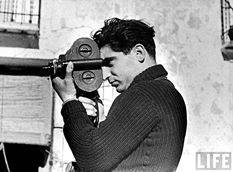
Over the next three decades, the documentary style became instrumental in covering major world conflicts. In Europe, it became associated with the news agency Magnum, founded in 1947 with offices in New York and Paris. This international news agency embraced individual approaches to documentary photography. The agency's founding members were: Robert Capa, Henri Cartier-Bresson, David (Chim) Seymour, George Rodger, and William Vandivert. Each photographer had a readily identifiable individual style. Robert Capa, Hungarian-born photojournalist, exemplified the Magnum photographer: the globetrotting heroic photojournalist, who moves between cultures documenting everything happening in the world. For Capa, it started with his coverage of the Spanish Civil War and on through the second World War. Photojournalists like Capa and Henri Cartier-Bresson depicted the allies entry into WWII as well as the horrors of the French refugee camps at the end of the war, as reflected in Capa's D-Day (1944) and Cartier-Bresson's Accused Gestapo Informer, Dessau, Germany (1945). Evidently Magnum, influenced by Cartier-Bresson, emphasized the chance encounters and random incidents, which define the photograph's meaning.
In the United States, photojournalism was closely associated with the work of Margaret Bourke-White, who documented the nation's industrial achievements as in the creation of Fort Peck dam in her New Deal, Montana: Fort Peck Dam (1936) for Life magazine. Photojournalism in both the United States and Europe continued to sustain Straight photography's artistic sensibility as it shaped the world's news stories in arresting images in the pages of the highly-popular illustrated magazines: Life, Fortune, Time, Paris Match, Epoca, among others.
Straight Photography: Concepts, Styles, and Trends
Straight photography, identified with a pure approach to the medium, was used across all fields of photography and different styles: from avant-garde photographs, documentary and street photography, to abstract photography. Each photographic style adapted the approach to emphasize its own treatment of form, sensory experience, or the changes in the social and cultural environment.
Social Documentary Photography and Street Photography
Social documentary photographers draw attention to the social conditions that need social reform or to convey the underlying power structures causing social problems. For instance, Walker Evan's famous image, Allie Mae Burroughs, wife of cotton sharecropper, Hale County, Alabama (1936) highlighted the plight of poor sharecroppers and the need for social reform during the Great Depression. Evans emphasized the photograph as "fact," yet aimed to create images that had a lyrical quality. As he said, with the images he wanted to "make an attack on the establishment... wanting to disturb them." Consequently, the documentary photograph needs to be seen in relation to the world, from where it was taken and the histories associated with it.
Street photography adopted a casual, yet candid view of human activity in public spaces and in the city. Evan's series Subway Portraits simply captured people at moments on the subway, lost in thought, in mid conversation, reading a newspaper; these images describe a reality often overlooked in the anonymous space of the underground. These photographs impacted the work of street photographers such as Lee Friedlander, Robert Frank, and Helen Levitt. Street photography created ambivalent images alert to the city's modernity and its human inhabitants. New responses, however, continuously emerge to register the ever-changing metropolises as diverse as Mexico City, Bombay, Shanghai, Tokyo.
Photojournalism
With the rise of the Nazi Era, and the outbreak of World War II, photojournalism earned the reputation for providing truthful and objective images of world events in the illustrated press. Magnum Photos, the first international photographic cooperative, exemplified the highest standard in the field of photojournalism. Their ethical and socially conscious approach to documenting events lent credibility to the news stories based on their photographs.
In the years following World War II, Photojournalism with its straight approach became profoundly connected to ethical questions of authenticity, objectivity, and accuracy in reporting. As the photo-historian Fred Ritchen contends, the language of photojournalism was forged in adversity - "a tragic history related through photography." With the Vietnam war, a crisis of loyalty occurred and the politically committed photographer protested against and "denounced the hypocrisy of the cause of the conflict and its gratuitous violence." After this war, it would become more difficult for American photojournalists to gain access to areas of conflict and to have such a freehand at reporting.
Due to the advent of Photoshop the manipulation of the image has become more easily achieved and disguised. Still news photographs are expected to provide accurate information as well as in their captions to avoid casting aspersion upon the photograph and the photographer. For instance, in 2015, 20% of the photographic entries for the World Press Photo Award were disqualified for being manipulated, and a major prize was withdrawn after the winner was found to have staged images and provided misleading captions.
Abstract Photography
Abstract photography emphasized the experimental and conceptual character of the photograph. It uses composition, line, color, and forms that may or may not have an association with objects in the world. Some abstract photographers sought out the details of the city or landscape rather than the experimental possibilities of the medium. For instance, Aaron Siskind, a noted social documentary photographer, who depicted life in Harlem in his photo book Harlem Document (1932-40), began to take extreme close-ups of subjects in the early 1940s. This led to works like Jerome, Arizona 21 (1949) where a close-up of peeling paint on a wall becomes an abstraction of shape and form. Inspired by Edward Weston to take up photography, Frederick Sommer used a large format camera to document the desert landscape and adopted innovative framing techniques, for instance, photographing the desert without a horizon to create, what he called, "constellations" as the landscape itself approached abstraction.
László Moholy-Nagy's "New Vision" in photography experimented with the medium, its unconventional forms and techniques, to give the image a graphic structure. Some of his techniques included a simple photogram (placing an object directly on the light-sensitive paper and exposing it to light), photomontages, the combination of photographs and modern typography, or unusual angles, such as the close-up. Moholy-Nagy's photograms from the twenties are one of the many ways he experimented with the medium. As painter, photographer, sculptor, and filmmaker as well as graphic, exhibition, and state designer, Moholy-Nagy believed in the power of images and advocated for the integration of art and technology.
Later Developments - After Straight Photography
Photography's power to mirror reality shaped the Straight approach to create an ideal, yet honest picture. The influence of American Straight photography can be found as late as the 1970s in the work of Czech photographer Josef Sudek. However, given the prevalence of the photographic image and its use by democratic and dictatorial governments alike to promote their various national agendas in the post WWII period, progressive artists and photographers inevitably critiqued the media's universal claims. Conceptual photographers in the 1970s, in particular Douglas Hubler, sought to break down the conventions of documentary photography and provoke viewers to examine their visual culture. Postmodernism attacked photography's neutral, objective images. Photographers such as Andreas Gursky and Cindy Sherman resented the documentary approach, because as the art critic Deborah Solomon explained: "They resented the street aesthetic or documentary approach because they wanted to show that all photography - even the most seemingly real - is an illusion. They thought it was silly to pretend that documentary photography offers truths."
As a result, the viability of both the artistic and documentary photograph are still debated, given the proliferation of technology, cell phone cameras and digital software, which has resulted in an explosion of images. The photographer Stephen Mayes in a Time magazine 2015 issue argued, "We'll look back at the black-and-white photograph that was the voice of truth for nearly a century, as a simplistic and incomplete source of information about what was happening in the world."
Nonetheless, Straight photography persisted to define a vision of how we interact with the world into the late-20th and early-21st centuries. Inspired by their awareness of time, some photographers interestingly used the concept of the snapshot, tied to the fleeting experience of life, to explore the daily aspects of their own lives and/or local cultures, such as Martin Parr, Wolfgang Tillmans, Richard Billingham and Nan Goldin. Simultaneously other photographers have reinterpreted the concept of the series, by photographing a single subject over an extended period of time, as seen in the Dutch photographer Rineke Dijkstra's work Israeli Soldiers (1999-2003) that depicts a young woman at various points in her year and a half stint in the Israeli army. For many artists, the camera became the ultimate tool for revealing what would otherwise remain obscured or hidden from view.
Other 21st-century artists, however, continue to interrogate and reinvent the medium of photography anew, as in the work of Matthew Brandt, Marco Breuer, Lisa Oppenheim, Alison Rossiter, and James Welling, who continue to evoke the abstract and formal vocabularies used by modernist photographers in the twenties and thirties.
Useful Resources on Straight Photography
- Berenice Abbott: American PhotographerBy Hank O'Neal and Berenice Abbott
- Ansel Adams: A BiographyOur PickBy Mary Street Alinder
- Daybooks of Edward Weston: I. Mexico. II. CaliforniaBy Edward Weston, edited by Nancy Newhall Weston
- Seeing Straight: The F.64 Revolution in PhotographyBy Mary Street Alinder
- AtgetOur PickBy John Szarkowski and Eugène Atget
- Eugène Atget: Masters of Photography SeriesBy Eugène Atget
- Walker Evans: Masters of Photography SeriesBy Walker Evans and Dr. David Campany
- Paul Strand: Master of Modern PhotographyOur PickBy Peter Barberie, Amanda Block, Martin Barnes, et al.
- Manuel Alvarez Bravo: Masters of Photography SeriesBy Manuel Alvarez Bravo
- Manuel Álvarez Bravo, Henri Cartier-Bresson And Walker Evans: Documentary And Anti-Graphic Photographs: A Reconstruction of the 1935 Exhibition at the Julien Levy Gallery in New YorkBy Jeff Rosenheim, Manuel Álvarez Bravo, Henri Cartier-Bresson, and Walker Evans
- Moholy-Nagy: Future Present.By Matthew S. Witkovsky, Carol S. Eliel
- Light, Paper, Process: Reinventing PhotographyBy Virginia Heckert
